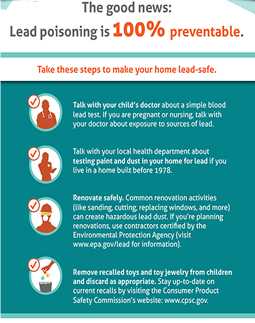Information for Parents
Prevent Children’s Exposure to Lead
Lead poisoning can be prevented. The key is to keep children from coming in contact with lead. If children are lead poisoned they must be treated. Learn how to prevent children’s exposure to lead.
There are many ways you can reduce children's exposure to lead before they are harmed. Lead hazards in a child's environment must be identified and controlled or removed safely. Lead is invisible to the naked eye and has no smell.
Sources of Lead
A child's environment is full of lead. Children are exposed to lead from different sources (such as paint, gasoline, solder, and consumer products) and through different pathways (such as air, food, water, dust, and soil). Although there are several exposure sources, lead-based paint is the most widespread and dangerous high-dose source of lead exposure for young children.
At-Risk Populations
Children at higher risk for lead exposure
- are poor,
- are members of racial-ethnic minority groups,
- are recent immigrants,
- live in older, poorly maintained rental properties, or
- have parents who are exposed to lead at work.
Membership in one of these groups does not predict risk in every community, and children in these groups who are not exposed to lead do not have elevated blood lead levels.
Check out our information on
- Lead poisoning prevention and international adoption for prospective parents adopting a child from overseas.
- Lead poisoning prevention for pregnant women.
Get Treatment if You Think Your Child Has Been in Contact with Lead
If you think your child has been in contact with lead, contact your child's health care provider. He or she can help you decide whether to test your child's blood to see if it has high levels of lead.
A blood lead test is the only way to find out if your child has a high lead level. Most children with high levels of lead in their blood have no symptoms.
Your child's health care provider can recommend treatment if your child has been exposed to lead.
See frequently asked questions about lead and possible lead exposure.
Additional Resources for Parents
5 Things You Can Do: Fact sheet with information on how to help lower elevated blood lead levels; in English[PDF - 128 KB] and en Español[PDF - 186 KB]
Are You Pregnant?: Fact sheet with lead poisoning prevention information for pregnant women; in English[PDF - 128 KB] and en Español[PDF - 86 KB]
Know the Facts: Fact sheet with general lead poisoning prevention information; in English[PDF - 276 KB] and en Español[PDF - 220 KB]
Blood Lead Levels in Children [PDF - 292 KB]: Fact sheet with an update on blood lead levels in children.
Ethan's House Gets Healthier with a Visit from the Lead Poisoning Prevention Team [PDF - 2.83 MB]: Children’s coloring book on making a home lead safe.
Information about Lead: Video about lead; in American Sign Language.
Lead Poisoning: Words to Know[PDF - 1.33 MB]: Dictionary that gives the meaning of words you often hear or read about lead.
A Healthy Home for Everyone: The Guide for Families and Individuals[PDF - 2.56 MB]: Booklet with information about the connection between housing and health.
- Page last reviewed: December 8, 2015
- Page last updated: December 8, 2015
- Content source:
National Center for Environmental Health, Division of Emergency and Environmental Health Services


 ShareCompartir
ShareCompartir
